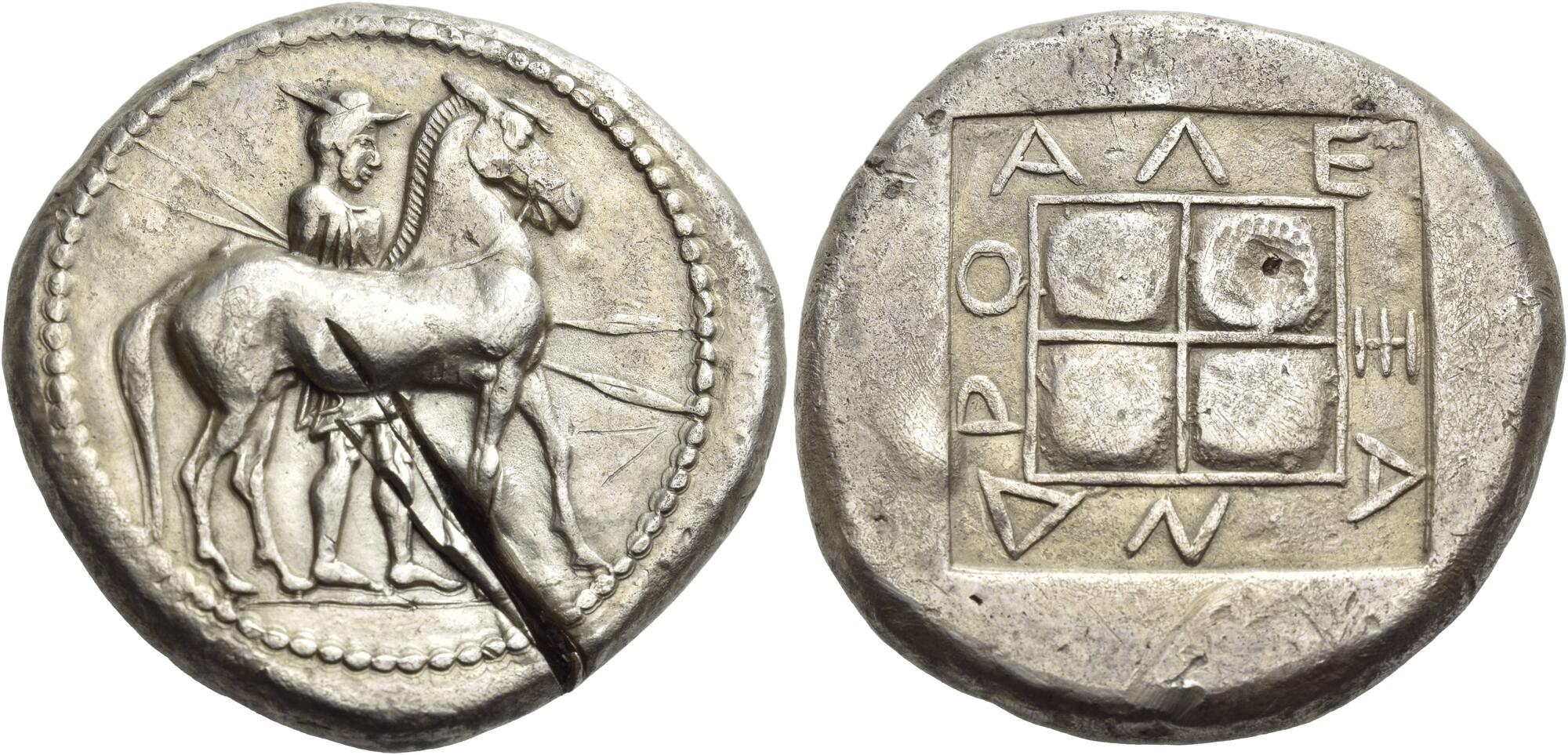AC 163 - Aigai (Alexander I), silver, octodrachms (480-451 BCE)
From SILVER
480 BCE - 451 BCE Silver 58,412 kg
Description
| ObverseInscription or printing placed on the obverse.: | Horseman, wearing petasos and chlamys, standing right, holding two spears, behind bridled horse standing right. |
| ReverseInscription or printing placed on the reverse.: | ΑΛΕ-ΞΑ-ΝΔ-ΡΟ (Greek).Inscription in shallow incuse square around quadripartite square in relief. |
Mint and issuing power
| MintIdentifies the place of manufacture or issue of a numismatic object.: | Aigai | Ancient regionAncient region.: | Macedon | Modern countryModern country: Greece | AuthorityIdentifies the issuing power. The authority can be "pretended" when the name or the portrait of X is on the coin but he/she was not the issuing power. It can also be "uncertain" when there is no mention of X on the coin but he/she was the issuing power according to the historical sources: | Alexander I of Macedon (Argead king, c. 498-454 BC) |
Chronology
| FromIdentifies the initial date in a range assigned in a numismatic context. | 480 BCE | toIdentifies the final date in a range assigned in a numismatic context.. | 451 BCE | PeriodTime period of the numismatic object.: Classical 480-323 BC |
Physical description
| MetalThe physical material (usually metal) from which an object is made.: | Silver |
Median weightMedian of the weights of numismatic objects (in grams). in grams | 29.00 | DenominationTerm indicating the value of a numismatic object. Examples: tetradrachm, chalkous, denarius.: | octodrachm |
StandardStandard.: |
Image

AC163 Aigai.jpeg [1]
References
| Die study referencePublication of the study: | Raymond 19531Raymond 1953, n° 1-7a, 45-57 et 108-11. | ||
| Coin series referenceReference to coin series study: | HGC 3.12HGC 3.1, n° 755, RQEMAC3RQEMAC, n° 163 | ||
| Coin series web referenceCoin series web references: | |||
Obverse dies distribution
| FrequencyFrequency of specimen in distribution. ᵖ | Number of obversesNumber of obverse dies. ᵖ (o) | % (o) | Number of coinsNumber of coins. (n) | % (n) | Die nameName(s) of the die(s). |
| 1 | 17 | 80.95 | 17 | 68 | 1, 2, 3, 4, 5, 6, 7, 8, 9, 10, 11, 15, 16, 17, 18, 19, 21 |
| 2 | 4 | 19.05 | 8 | 32 | 12, 13, 14, 20 |
| Total | 21 of 21 | 100 | 25 of 25 | 100 |
Reverse dies distribution
no distribution is available
Quantification
| Number of obversesNumber of obverse dies. ᵖ (o) | 21 | Number of singletons (o1)The number of singleton coins. ᵖ | 17 |
| Number of reverse diesNumber of reverse dies. (r) | 19 | Number of coinsNumber of coins. (n) | 25 |
| Coins per obverse dieNumber of coins per obverse die. (n/o) | 1.19 | Coins per reverse dieNumber of coins per reverse die. (n/r) | 1.32 |
| Reverse per obverse ratioRatio of obverse dies divided by reverse dies. (r/o) | 0.9 | Percentage of singletons (o1)number of coins (n) divided by the number of singletons (o1) ᵖ | 80.95 % |
| Original number of dies (O) (Carter 1983 formula)The estimation of the number of coins according to Carter 1983 ᵖ | 100.71 | Coins struck if 20,000 as average productivity per dieCoins made if the average productivity for obverses (according to Carter) is 20,000. ᵖ | 2,014,200 |
| Original number of dies (O) (Esty 2011 formula)The estimation of the number of coins according to the singleton formula in Esty 2011 ᵖ (O) | 131.25 | Survival rate if 20,000 as average productivity per dieSurvival rate if average productivity is 20,000. ᵖ | 0.00001 |
| Coverage (o = % of O) (Esty 1984 formula)Esty 1984 - coverage (% of O) ᵖ (o = % of O) | 32% | Die productivity if survival rate 1/2,000Average productivity if survival rate is 1/2,000. ᵖ | 496.48 |
| Weight of silver (in kg) if 20,000 coins per die (O = Carter formula)Carter 1983 * Median weight * 20000 (*10 if gold or electrum) ᵖ | 58,412 kg <br /> 58,412 kg | Die productivity if survival rate 1/5,000Average productivity if survival rate is 1/5,000. ᵖ | 1,241.19 |
Remarks